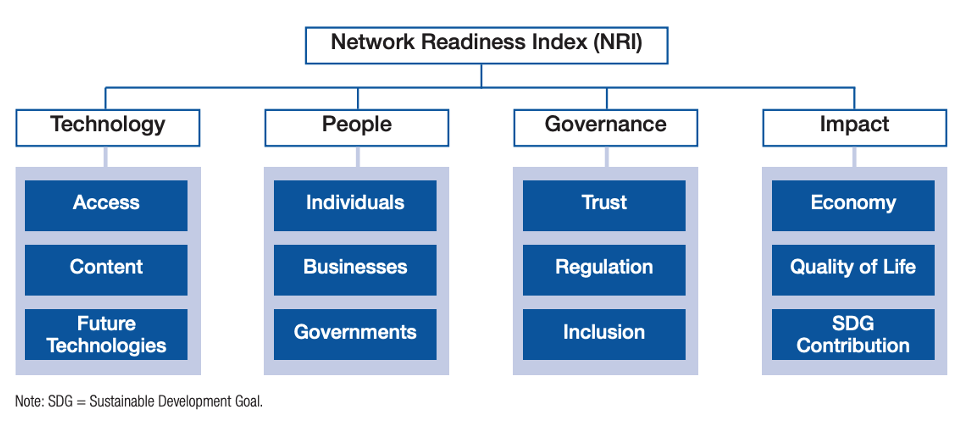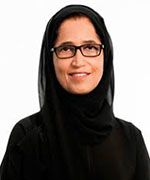This post kicks off a special series on the value and uses of the NRI and will include regional highlights.
The NRI, first launched in 2002 by the World Economic Forum, has been redesigned by its co-editors, Soumitra Dutta and Bruno Lanvin, Portulans Institute co-founders, to reflect how technology and people need to be integrated within an effective governance structure in order to have the right impact on the economy, society, and environment.
The 2019 NRI was constructed using a renewed development process, which involved the team reviewing and benchmarking over 30 other general or technology-specific indices. The team also reviewed the metrics and methodology used. This ultimately led to the NRI becoming an even more multi-dimensional concept.
The NRI is a composite index that rests on four pillars: Technology, People, Governance, and Impact. Each pillar is itself comprised of three sub-pillars, depicted in the table below. Furthermore, 62 indicators have been identified to populate these 12 sub-pillars. Details about these indicators can be found in Appendix II: Sources and Definitions located in our full report.
In terms of country and data coverage, the NRI includes nations and indicators based on the double threshold approach. This means that only countries with data available for at least 70 percent of all indicators are included in the NRI. Vice versa, a particular indicator is included in the NRI only if it is available for at least 70 percent of the world’s countries. The 2019 NRI covers 133 countries from the developing and developed world, representing over 98 percent of global GDP.

A tool for action
The NRI has provided, and continues to provide, a methodological framework that identifies the factors enabling national economies to fully benefit from information and communication technology (ICT) advances while highlighting the joint responsibility of all social actors, namely individuals, businesses, and governments, in this respect. Over the last 20 years, the NRI has established itself as one of the most comprehensive assessments of ICT readiness and has been used by an increasing number of governments as a basis for their national ICT strategies.
As countries around the world begin to develop, or continue to improve upon, their digital strategies, it is important for policymakers to first understand the strengths and weaknesses of their respective economies in order to construct a prosperous roadmap for the future. In order to do that, assessment tools such as the NRI can be precious, since they go beyond conventional data sources such as national statistics and expert surveys and help reflect the underlying digital content creation, capacities, and skills of a nation’s population.
While analyzing the findings of the NRI, one may question how two countries with similar GDPs per capita can perform very differently in the index. The answer is that some countries do better with less – they are more prepared and can thus be more competitive.
The NRI combines traditional and novel digitally based data sources to provide a more revealing view of the status of the world’s digital knowledge economy, all while highlighting where the availability or unavailability of digital resources may actually reinforce inequalities in the age of data. As a result, as the relevance and importance of technology will surely increase in the upcoming decade, it is of the utmost importance that countries lacking a sufficient level of data – 70 percent of all indicators – make appropriate changes in the future, as the NRI is a must-needed assessment tool for any country looking to prosper in the ever-growing technological era.
A leader’s experience with the NRI
Dr. Hessa Al-Jaber was the first-ever minister of information and communication technology in Qatar. She is also an advisor of Portulans Institute and the chairperson of Trio Investment, a technology investment company that invests in innovative technologies that address some of the most pressing health problems in the MENA region. She says the NRI was an incredibly helpful tool to support policy assessment and development while in office.
We spoke with Dr. Al-Jaber, a notable proponent of the Network Readiness Index, to better understand how the NRI was utilized while she was the head of ICT in Qatar.
Our discussion began with a description of the impact of the NRI on her work. “Our ICT strategy was guided by the NRI framework,” she said. “By using the NRI, it helped us to identify gaps, develop action, structure policy dialogue, and to track progress in ICT readiness over time. Ultimately, this allowed us to build an advanced ICT sector that helped Qatar diversify its economy and provide societal benefits for all.”
 Next, the conversation shifted to the future of ICT in Qatar and what to expect in the coming years. “Qatar must continue to build a competitive and vibrant economy, all while aiming to enhance the quality of life of its people by making the best use of technology and innovation,” Dr. Al-Jaber said. She continued by arguing that it is important for the nation “to identify the digital interventions that will help to transform key target industries within Qatar and subsequently support the diversification of the Qatari economy.”
Next, the conversation shifted to the future of ICT in Qatar and what to expect in the coming years. “Qatar must continue to build a competitive and vibrant economy, all while aiming to enhance the quality of life of its people by making the best use of technology and innovation,” Dr. Al-Jaber said. She continued by arguing that it is important for the nation “to identify the digital interventions that will help to transform key target industries within Qatar and subsequently support the diversification of the Qatari economy.”
At the conclusion of our pleasant discussion with Dr. Al-Jaber, she recommended the use of the NRI to all other countries around the world.
Navigating the NRI
To learn more about the NRI, check out our website, where you can find the full report, executive summary, country reports with detailed performance overviews, and thorough analysis. Additionally, make sure to sign up for our newsletter here so you can stay informed about any updates to the NRI.
The purpose of the NRI is to be a tool for contextual understanding and smart, data-based action. It is our hope that the data, inputs, and considerations contained in it can be of value to the decision-makers of private and public organizations to promote sustainable economic growth for their organizations and countries.
How can the NRI help you
Lastly, if you are interested in partnering with the Portulans Institute in order to produce analysis or a roadmap to improving the level of readiness within a specific region or country, you can reach us at info@portulansinstitute.org. We aim to improve readiness so that, in the future, countries can fully benefit from new technology.



